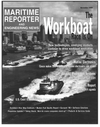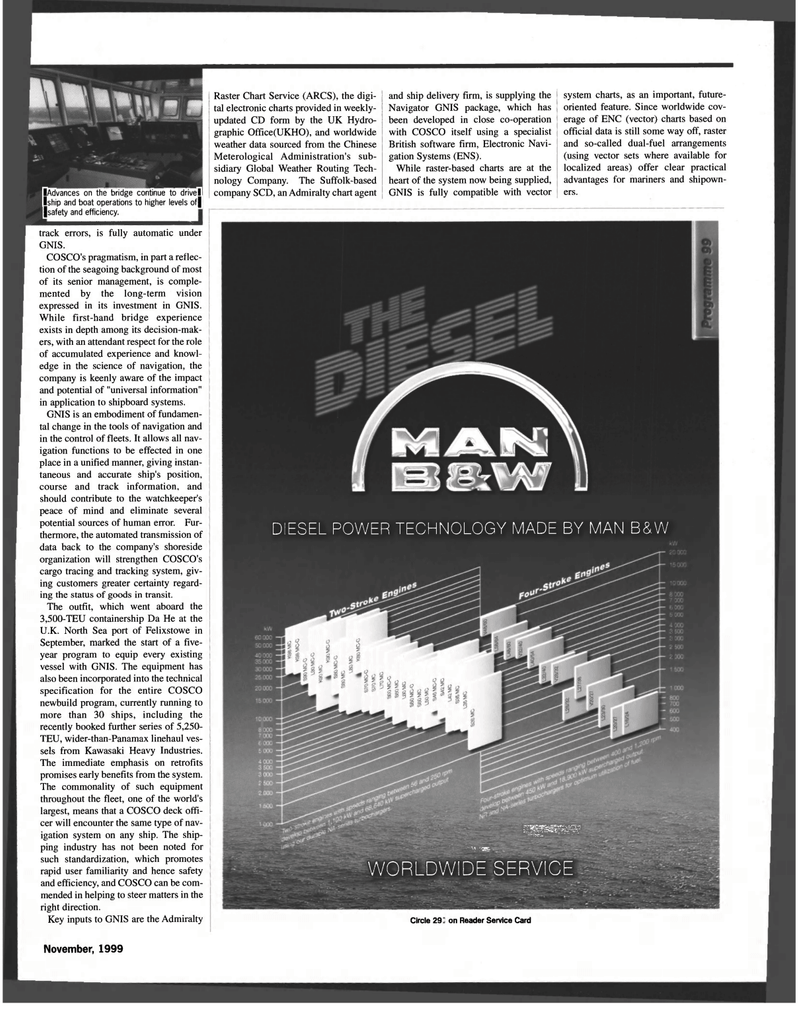
Page 67: of Maritime Reporter Magazine (November 1999)
Read this page in Pdf, Flash or Html5 edition of November 1999 Maritime Reporter Magazine
(Advances on the bridge continue to drivel lship and boat operations to higher levels of| |safety and efficiency. track errors, is fully automatic under GNIS. COSCO's pragmatism, in part a reflec-tion of the seagoing background of most of its senior management, is comple-mented by the long-term vision expressed in its investment in GNIS. While first-hand bridge experience exists in depth among its decision-mak-ers, with an attendant respect for the role of accumulated experience and knowl-edge in the science of navigation, the company is keenly aware of the impact and potential of "universal information" in application to shipboard systems. GNIS is an embodiment of fundamen-tal change in the tools of navigation and in the control of fleets. It allows all nav-igation functions to be effected in one place in a unified manner, giving instan-taneous and accurate ship's position, course and track information, and should contribute to the watchkeeper's peace of mind and eliminate several potential sources of human error. Fur-thermore, the automated transmission of data back to the company's shoreside organization will strengthen COSCO's cargo tracing and tracking system, giv-ing customers greater certainty regard-ing the status of goods in transit. The outfit, which went aboard the 3,500-TEU containership Da He at the U.K. North Sea port of Felixstowe in September, marked the start of a five-year program to equip every existing vessel with GNIS. The equipment has also been incorporated into the technical specification for the entire COSCO newbuild program, currently running to more than 30 ships, including the recently booked further series of 5,250-TEU, wider-than-Panamax linehaul ves-sels from Kawasaki Heavy Industries. The immediate emphasis on retrofits promises early benefits from the system. The commonality of such equipment throughout the fleet, one of the world's largest, means that a COSCO deck offi-cer will encounter the same type of nav-igation system on any ship. The ship-ping industry has not been noted for such standardization, which promotes rapid user familiarity and hence safety and efficiency, and COSCO can be com-mended in helping to steer matters in the right direction. Key inputs to GNIS are the Admiralty Raster Chart Service (ARCS), the digi-tal electronic charts provided in weekly-updated CD form by the UK Hydro-graphic Office(UKHO), and worldwide weather data sourced from the Chinese Meterological Administration's sub-sidiary Global Weather Routing Tech-nology Company. The Suffolk-based company SCD, an Admiralty chart agent and ship delivery firm, is supplying the Navigator GNIS package, which has been developed in close co-operation with COSCO itself using a specialist British software firm, Electronic Navi-gation Systems (ENS). While raster-based charts are at the heart of the system now being supplied, GNIS is fully compatible with vector system charts, as an important, future-oriented feature. Since worldwide cov-erage of ENC (vector) charts based on official data is still some way off, raster and so-called dual-fuel arrangements (using vector sets where available for localized areas) offer clear practical advantages for mariners and shipown-ers. DIESEL POWER TECHNOLOGY MADE BY MAN B&W ggpipi m .'JW.» WORLDWIDE SERVICE Circle 229 on Reader Service Card Circle 256 on Reader Service Card November, 1999 69

 66
66

 68
68
